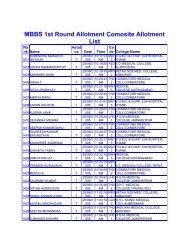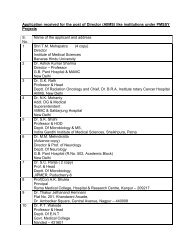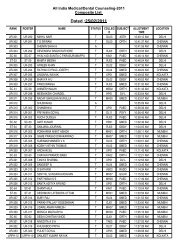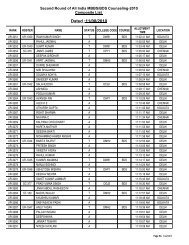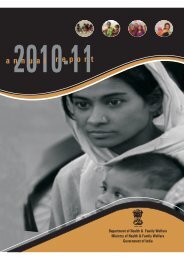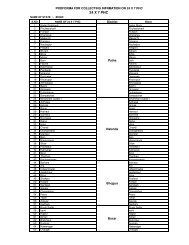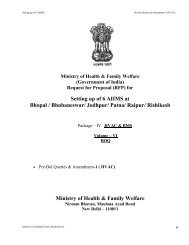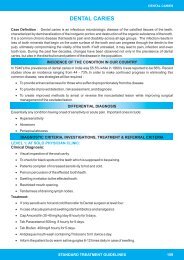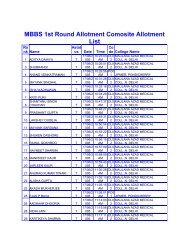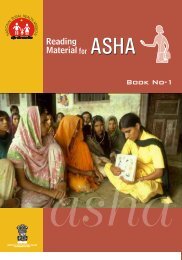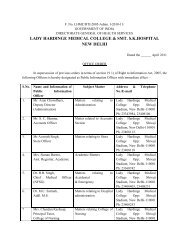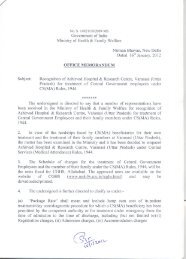National Vaccine Policy Book - Ministry of Health and Family Welfare
National Vaccine Policy Book - Ministry of Health and Family Welfare
National Vaccine Policy Book - Ministry of Health and Family Welfare
You also want an ePaper? Increase the reach of your titles
YUMPU automatically turns print PDFs into web optimized ePapers that Google loves.
NABL <strong>National</strong> Accreditation Board for Testing <strong>and</strong> Calibration <strong>of</strong><br />
Laboratories<br />
NDMA <strong>National</strong> Disaster Management Authority<br />
NIB <strong>National</strong> Institute <strong>of</strong> Biologicals<br />
NIHFW <strong>National</strong> Institute <strong>of</strong> <strong>Health</strong> <strong>and</strong> <strong>Family</strong> <strong>Welfare</strong><br />
NIP <strong>National</strong> Immunization Program<br />
NRA <strong>National</strong> Regulatory Authority<br />
NRHM <strong>National</strong> Rural <strong>Health</strong> Mission<br />
NTAGI <strong>National</strong> Technical Advisory Group on Immunization<br />
OPV Oral Polio <strong>Vaccine</strong><br />
PAHO Pan American <strong>Health</strong> Organization<br />
ProMIS Procurement Management Information System<br />
PSU Public Sector Unit<br />
RCH-2 Reproductive <strong>and</strong> Child <strong>Health</strong> Phase II<br />
SAGE Strategic Advisory Group <strong>of</strong> Experts<br />
SAIF Sophisticated <strong>and</strong> Analytical Instrument Facilities<br />
UIP Universal Immunization Program<br />
UNICEF United Nations Children’s Fund<br />
VPD <strong>Vaccine</strong> Preventable Disease<br />
WHO World <strong>Health</strong> Organization<br />
EXECUTIVE SUMMARY<br />
<strong>Vaccine</strong>s are one <strong>of</strong> the most successful health interventions that bring<br />
about significant reductions in infectious diseases <strong>and</strong> adverse health<br />
consequences <strong>and</strong> improve quality <strong>of</strong> life in the population. Over the years<br />
vaccines have provided highly cost effective improvements to human health<br />
by reducing avoidable human suffering, costs <strong>of</strong> care <strong>and</strong> treatment,<br />
economic consequences <strong>of</strong> work i.e. lower productivity <strong>and</strong> loss <strong>of</strong> work.<br />
More <strong>and</strong> more diseases are becoming vaccine preventable; including<br />
those for prominent killers like pneumonia <strong>and</strong> diarrhoea, <strong>and</strong> the<br />
technology used is evolving rapidly. Since vaccines are administered to<br />
healthy people, especially children, it is pivotal to ascertain they are safe<br />
<strong>and</strong> cost effective. Consequently vaccine development has become time<br />
<strong>and</strong> resource intensive, with more stringent regulatory pathways to ensure<br />
safety <strong>and</strong> efficacy <strong>of</strong> vaccines. In a situation where there is abundance <strong>of</strong><br />
new <strong>and</strong> expensive vaccines on one h<strong>and</strong> <strong>and</strong> limitations <strong>of</strong> resources on<br />
the other, it becomes imperative that use <strong>of</strong> vaccines through induction in<br />
the Universal Immunization Program (UIP) as well as in the free market is<br />
done through a framework <strong>of</strong> decision-making that confers positive health<br />
<strong>and</strong> economic benefits to the society.<br />
The UIP in India targets 2.7 Crores infants <strong>and</strong> 3.0 Crores pregnant women<br />
every year <strong>and</strong> is one <strong>of</strong> the largest in the world. The country also has a<br />
strong vaccine manufacturing capacity that has recently taken on the<br />
challenge <strong>of</strong> producing more complex vaccines. Most <strong>of</strong> the new vaccines<br />
are used by one segment <strong>of</strong> the population, which can afford them, while the<br />
most vulnerable segment <strong>of</strong> the population, which is serviced through the<br />
UIP misses out on this opportunity. There is a scope for improvement in the<br />
health system <strong>and</strong> the vaccine enterprise in the country to enable its optimal<br />
functioning <strong>and</strong> bring about coordination between the various interdependent<br />
steps <strong>and</strong> involved stakeholders. This policy document deals<br />
with issues critical to strengthening <strong>of</strong> the vaccine enterprise to ensure longterm<br />
supply <strong>of</strong> affordable vaccines to the people who need it the most. The<br />
document is divided under the following sections:<br />
• <strong>Policy</strong> context <strong>and</strong> framework : This section provides information<br />
on why this document is required, what is the scope <strong>of</strong> the document<br />
<strong>and</strong> overall framework.<br />
• Burden <strong>of</strong> <strong>Vaccine</strong> Preventable Diseases (VPDs) in India: This<br />
section discusses how introduction <strong>of</strong> vaccines have impacted the<br />
burden <strong>of</strong> VPDs in India. It also outlines other diseases which can be<br />
(iv) 01




